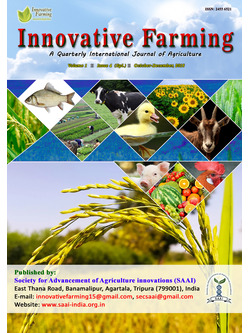
Effect of Various Levels of Protein and Energy Diets on Crossbred T&D Pigs Feed Locally Available Feed Ingredients
Satish Kumar*
Sundaresan School of Animal Husbandry and Dairying, Sam Higginbottom Institute of Agriculture, Technology and Sciences, Allahabad, U.P. - 211007, India
Neeraj
Sundaresan School of Animal Husbandry and Dairying, Sam Higginbottom Institute of Agriculture, Technology and Sciences, Allahabad, U.P. - 211007, India
Sushil Prasad
Dept. of LPM, Ranchi Veterinary College, Birsa Agricultural University, Kanke, Ranchi - 834003, India
DOI: NIL
Keywords: Body weight, Energy diet, Pig, Protein diet
Abstract
Pig has a great potential to contribute to better economic return to the farmers. A balanced diet having proper ratio of energy and protein need to be prepared to make the pig farming economical. The present study was carried out on over 30 growing three months old crossbred piglets to evaluate the energy and protein requirement in growing and finishing pigs. Accordingly, five diets were prepared viz. T1 (Medium energy (75%) and medium protein diet (18%); T2 (Medium energy (75%) and low protein diet (16.20); T3 (Low energy (67.50%) and high protein diet (19.80%); T4 (Low energy (67.50%) and medium protein diet (18%) and T5 (Low energy (67.50%) and Low protein diet (16.20%). Average dry matter intake and weekly growth body weight gain were observed to be non-significant among groups. Slightly better performance were observed in group 1 followed by 4, 5, 3 and 2. Total body weight gain after 23rd week of experiment were observed to be 62.33, 59.42, 59.88, 59.67 and 59.73 for group 1, 2, 3, 4 and 5 respectively. The overall average daily gain was 380.99±31.09, 369.07±29.46, 371.93±32.61, 376.27±45.49 and 371.68±35.25 g per piglets in treatments 1, 2, 3, 4 and 5, respectively.
Downloads
not found
Reference
Adesehinwa, A. O. K. and Ogunmodede, B. K. 1995. Swine feeds and practical feed composition techniques. In: N.A.E.R.L.S. workshop training manual, Moor plantation, Ibadan (April 3–7, 1995). Nat. Pig Prod. pp. 27–56.
Agarwala, O. P. 1961. Efficiency of feed utilization of desi vs. Yorkshire graded pigs from three months to six months of age. Indian Veterinary Journal, 56: 412–415.
Balaji, N. S., Sivaraman, T., Sivakumar, T. and Ramesh, V. 2006. Influence of castration on growth rate and body measurements in large white Yorkshire pig. Indian Journal of Animal Research, 40(2): 123–126.
Carpenter, D. A., O’Mara, F. P. and O'Doherty, J. V. 2004. The effect of dietary crude protein concentration on growth performance, carcass composition and nitrogen excretion in entire grower–finisher pigs. Irish Journal of Agricultural and Food Research, 43: 227–236.
Church, D. C. 1991. Livestock feeds and feeding, 3rd ed. Prentice Hall, Inc., Englewood Cliffs, New Jersey.
Ellis, and Nesbit, E. S. 1958. Various level of protein and crude fiber effect on feed-lot performance and carcass characteristics in swine. Journal of Animal Science, 17: 13.
Fernandez, J. A. and Jorgensen, J. N. 1986. Digestibility and absorption of nutrients as affected by fibre content in the diet of the pig. Livestock Production Science, 15: 53–71.
NRC. 1988. Nutrient requirements of swine, National Research Council. National Academy of Sciences, Washington, D.C.
Niba, A. T., Boukila, B., Fontheh, F. A., Djoukam, J., Tchoumboue, J. and Ngoua, F. N. 2005. Effect of castration and protein level of diet on the growth performance of piglets. Cameroon Journal of Experimental Biology, 1: 15–20.
Noblet, J., Henry, Y. and Dubois, S. 1987. Effect of protein and lysine levels in the diet on body gain composition and energy utilization in growing pigs. Journal of Animal Science, 65: 717–726.
Noblet, J., Henry, Y. and Dubois, S. 1994. Prediction of net energy value of feeds for growing pigs. Journal of Animal Science, 72: 344–354.
Noblet, J. and Le Goff, G. 2001. Effect of dietary fibre on the energy value of feeds for pigs. Animal Feed Science and Technology, 90: 35–52.
Quinion, N., Dubois, S. and Noblet, J. 1995. Effect of dietary crude protein level on protein and energy in growing pigs. Comparison of two measurement methods. Livestock Production Science, 41: 51–61.
Ranjhan, S. K., Gupta, B. S., Chabra, S. S. and Dhudapker, B. S. 1971. Effect of various levels of crude fibre and energy in the rations of growing middle White Yorkshire pigs. Indian Journal of Animal Sciences, 41: 373–376.
Snedecor, G. W. and Cochran, W. G. 1994. Statistical methods, 8th edition. Iowa State University Press, Ames, Iowa.
